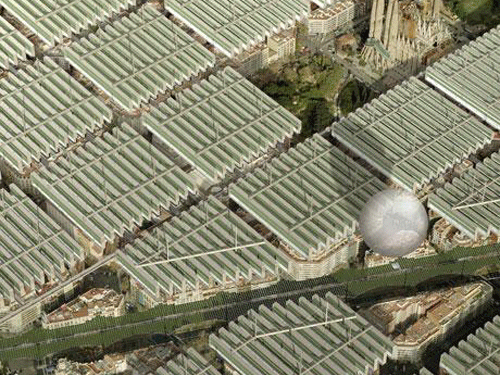This year, Urban farming is a hotter topic than ever before…
“In February, Mayor Mike McGinn and Seattle City Councilmembers announced the “2010: The Year of Urban Agriculture” campaign to promote urban agriculture efforts and increase community access to locally grown food.”
… and not only in Seattle. September this year, at the Rotterdam Harvest (Oogst) Festival, the planning department of Rotterdam presented a plan for urban agriculture in that city. Local urban agriculture organizations are mushrooming around the globe and dozens of debates and events are held.
Let´s see what else is going on in urban agriculture and which questions are at the center of the current debate.

1: Urban agriculture as an answer to urban decay
Many initiatives for urban agriculture arise from the existence of urban voids. Abandoned urban land is often the result of financial crises and loses its productive function during a period of time. The Zuidas development area in Amsterdam, for example, is rather paralised by the current real estate crisis and therefore copes with vacant lots at this moment. Temporarily an entire block has been transformed into a corn field with a pig farm and tennis courts in the middle.
September this year Stipo and Cities organized the seminar ‘Farming the City: Temporary Urban Agriculture in Amsterdam’, to explore current trends in urban agriculture and ways to stimulate initiatives in temporary use of vacant land for farming. A number of questions were posed: How can the (economic) benefits of urban agriculture be assessed? How can excessive bureaucracy around this kind of temporary use be avoided? How to deal with pollution in urban brownfields? How to organize and represent all small initiatives together?
In Detroit, more than just a temporary crisis occurs. The vast abandoned inner city areas are screaming for new use and the city is desperate for new jobs, after GM and other automobile manufacturers went bankrupt. Fast Company writes:
“A quarter of the city is nothing more than vacant lots–40 square miles of “urban prairie.” […] And what will Bing [the mayor] do with all of that empty space? Turn over as many as 10,000 acres to John Hantz to farm.
The owner of an eponymous financial services firm, Hantz is prepared to sink $30 million of his personal fortune into coaxing peaches, plums, lettuce, and heirloom tomatoes from the ground (or in hydroponic greenhouses). In exchange, all he’s asking for is free tax-delinquent land and tax breaks on agriculture. The city is considering giving him both. Hantz told Fortune he’s aiming for an average cost of $3,000 per acre, valuing it no differently than outlying farmland. But he also promises to create hundreds of green jobs, grow a surplus of fresh produce for residents, attract tourists, and “reintroduce Detroiters to the beauty of nature.”

2: Urban agriculture as sustainable metropolitan food production
Despite all great initiatives and ideas, an important question remains whether urban food production can replace traditional country side farming. The Why Factory (TUDelft), with MVRDV and Stroom Den Haag investigated the possibility of producing food for the city The Hague, in the Netherlands, completely within the existing city limits. This turned out to be quite impossible or at least undesirable. A study of intensive food production in Barcelona gives a similar result. And even if it worked, if the entire food production of cities could take place inside the city itself, what on earth would become of the countryside? Jungle?

This does not mean, however, that urban agriculture leads nowhere. Perhaps the goals of urban agriculture should be set differently, for example emphasizing on social, cultural and ecological aspects, and not so much on economic effects. In the master plan for the suburban Shenyang university campus, a special role was maintained for the traditional rice cultivation in the area, as a landscape element. Besides creating a comfortable and interesting green space for students and employees, part of the land actually remains agricultural in a new urban context.

3: Urban agriculture: farming or gardening?
Indeed it seems unavoidable that part of our food, especially wheat, corn, soy etc., will be produced outside the city. Fresh vegetables, chickens and fruits, on the other hand, can perfectly be grown in urban areas, while at the same time providing a pleasant job or hobby for the inhabitants. This type of urban gardening fits perfectly with the existing local community initiatives, that mix food production and gardening with social networking, exchange of healthy recipes etc., for example as happens at re:farm the city. And yes, why shouldn´t the authorities promote and stimulate these activities?

And in case of an emergency, a city like Amsterdam could always produce its own food using empty office buildings. According a project by Jurgen Hoogendoorn (municipality of Amsterdam), green areas such as parks are way too small. If the current 1,3 million square meters of empty office space were transformed into highly productive greenhouses with LED lamps, just like illegal cannabis farms, food could be produced for about 2,6 million people.